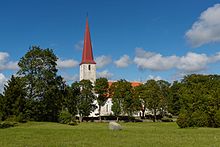Kihelkonna
Coordinates: 58 ° 22 ' N , 22 ° 2' E
Kihelkonna (German Kielkond ) is a village ( Estonian alevik ) in the rural municipality Saaremaa in the Saare district on the largest Estonian island Saaremaa . Until 2017, it was the capital of a rural community of the same name .
Population, location and history
The village has 340 inhabitants (as of December 31, 2011). It is located 33 kilometers northwest of the island's capital Kuressaare on the east coast of the Baltic Sea - Buch Kihelkonna ( Kihelkonna laht ).
There is a library and a school in the village. It goes back to the teaching institute founded in 1695 as a sexton school.
The importance of the local port was already emphasized in the Middle Ages. It became too flat due to the uplift of the country in the 20th century, so that it had to be relocated to nearby Jaagarahu .
church
The Evangelical Lutheran Church of St. Michaelis ( Mihkli kirik ) in Kihelkonna is one of the oldest Gothic churches in Estonia. Its construction was probably completed around 1270, around the same time as the church of Kaarma . Like the other churches on Saaremaa, the church was initially planned as a fortified church .
The 60 meter high west tower is the highest on the island. It was built in the pseudo-Gothic style in 1899 and served as a navigation mark until 2009 .
A few meters from the church is the original campanile , a simple, wood-covered stone building. The free-standing bell tower was built in 1638 and extensively renovated in 1968. Today it is the only one of its kind in the Baltic States .
The altar of the church dates from 1591. As is typical after the Reformation, the words of institution are attached to the side wings of the triptych , on one side in Latin and on the other in German. The altarpiece shows the Last Supper .
The narrow and small pulpit from 1604 is also a work of the Renaissance . It comes from an unknown master and is one of the oldest on the island. The current church windows date from 1980. They are the work of the glass painter Dolores Hoffmann .
The organ, inaugurated in 1805 with its late baroque facade, is the oldest still playable organ in Estonia. It was built in Pärnu by the Thuringian master Johann Andreas Stein (1752–1821). In 1890 it was rebuilt and expanded by the Jēkabpils organ builder Friedrich Weißenborn . One of the initiators of organ building was the then lord of the Lahetaguse and cultural lover Johann Wilhelm Ludwig von Luce (1756–1842).
graveyard
The place's current cemetery was probably created in the 1780s. To date, around 40,000 people have been buried there. There is a memorial stone for those who died in the Estonian War of Independence against Soviet Russia (1918–1920) and a communal grave for those who died in World War II .
literature
- Baltic historical local dictionary. Part 1: Estonia (including Northern Livonia) (= sources and studies on Baltic history. Volume 8/1). Started by Hans Feldmann . Published by Heinz von zur Mühlen . Edited by Gertrud Westermann . Böhlau, Cologne / Vienna 1985, ISBN 3-412-07183-8 , pp. 225f.
Web links
- Description ( eestigiid.ee )
- Entry in Eesti Entsüklopeedia (online version)
Individual evidence
- ↑ Estonian Statistical Office
- ↑ Archived copy ( Memento of the original from March 4, 2016 in the Internet Archive ) Info: The archive link was inserted automatically and has not yet been checked. Please check the original and archive link according to the instructions and then remove this notice.





